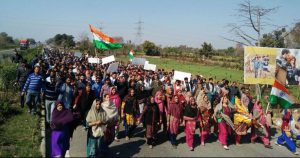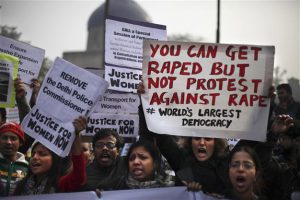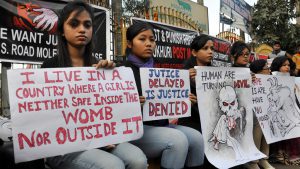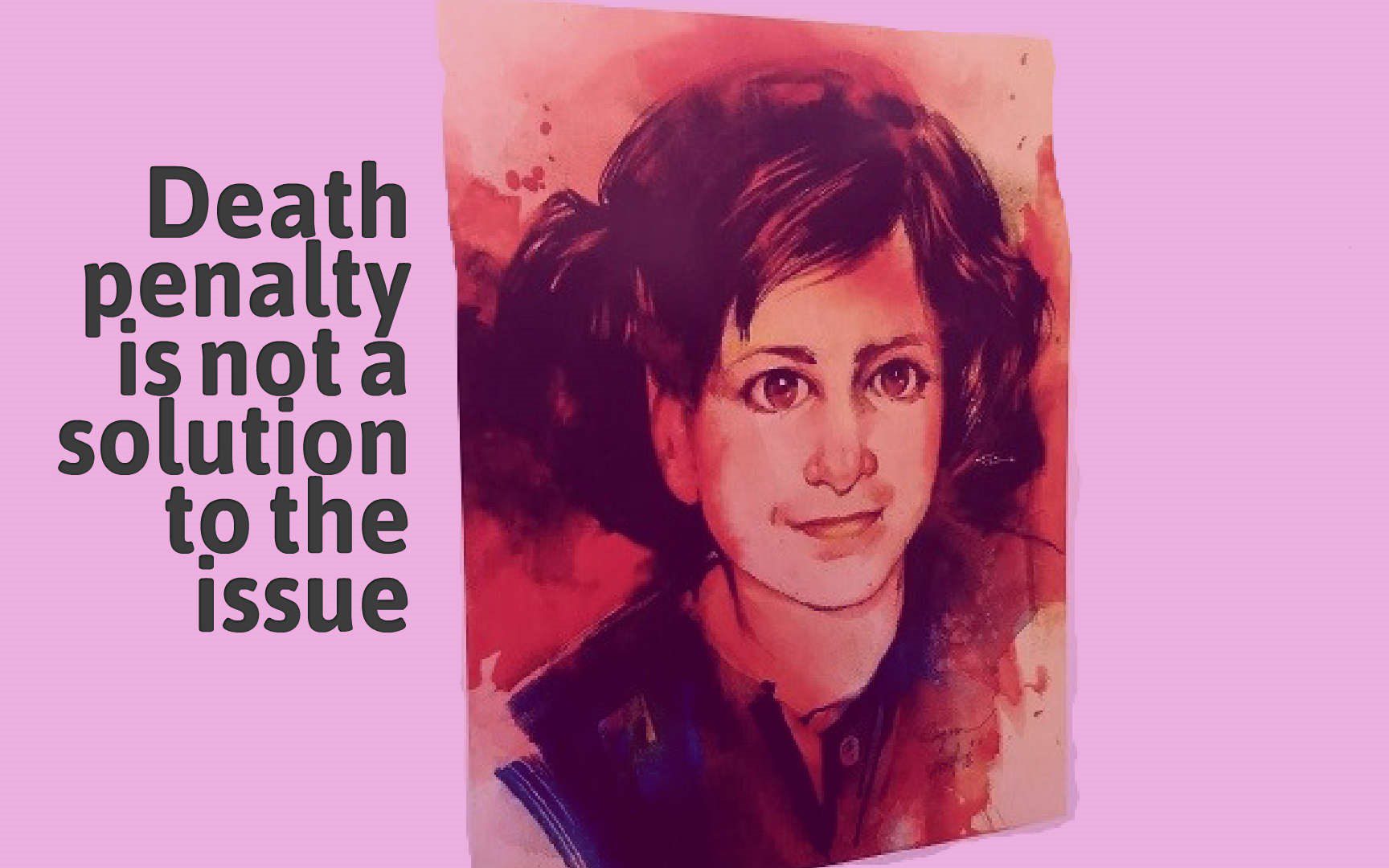The death penalty of convicts, definitely, does not hold an answer to the burning question of a rise in rape and related crimes. Even Justice Verma Committee has said, “…death penalty would be a regressive step in the field of sentencing and reformation.” Earlier, in the case of Nirbhaya, in December 2012, a similar demand was raised. It was even condemned by the United Nations as now in Kathua rape case. But then the government formed a three-member committee headed by a retired Chief Justice of India. The committee took 29 days, considered 80,000 suggestions, petitions raised from NGOs, lawyers and academicians, etc. This committee was under extreme pressure due to nationwide protests. Manish critiques the amendments to POSCO and rape laws, exclusively for Different Truths.
The incident of gruesome rape and murder of an eight-year-old girl in Kathua, Jammu & Kashmir shook the entire nation. The incident remained a burning subject in print, electronic and social media as people from all walks of life presented their take on the matter. A section of the population looked it from the communal lens as a biased crime against a Muslim tribe – Bakhrwals. It was asserted that the incident is a reflection of the aversion towards Muslims by hothead Hindu nationalists. The body of the girl was found in the forest, and according to the media she even dragged herself and tried to seek help and in order to prevent her perpetrators from doing so. She was murdered. This narrates the cruelty of the incidence. The seraphic face of the eight-year-old with beautiful large eyes shown in newspapers and TV screens bled the hearts of millions of Indians. It shocked the people and the nation which erupted in continuous protests at every corner of the country.
However, this was not the sole case of sexual brutality, everyday newspapers are filled with such cases. On 16th June 2017, a 14-year-old girl was gang-raped by six minors and then thrown out from moving train in Bihar. Near that incident, a 19-year-old mother with an 8-month-old infant was gang-raped in Gurugram’s Manesar in a shared auto by the driver and two other men on board. When the baby started crying, the rapists threw the baby out on the road, dashing it to death.
On 9th May 2017, the decomposed body of a 23-year-old girl was found near the industrial town of Rohtak, who was gang-raped after which her skull was smashed with bricks. A college girl in Bihar’s Khagaria district was raped and then set on fire by her boyfriend inside her own home. A seven-year-old, who was sleeping next to her mother, was picked up from her house in Amreha Budawan village in UP and raped. She was found in a pool of blood in fields nearby by village members. The list is endless. Every such barbaric incident is followed by public outrage in terms of protests and marches. However, Kathua case followed a slightly different path.

Caption Pic 2: The Hindu Ekta Manch protest in favour of the accused in the Kathua rape case. Credit: Twitter/Files
Hindu Ekta Manch (HEM) in Kathua, organised a rally for the support of the accused, which was attended by two ministers of the ruling government. All attempts were made to tamper with the investigations and influence investigating agencies also blaming the police for targeting innocents. The founding members of HEM and main accused of the case Sanjhi Ram, also a retired revenue official, who formed HEM week after the body of the survivor was found in the Rasana Village Forest in Kathua, Jammu. All prime accused of the case including juvenile were from the same area. The HEM has appealed to the people in Kathua case and demanded donations to hire lawyers on behalf of accused to demand Central Bureau of Investigation inquiry in rape and murder of an eight-year-old girl but the appeal didn’t get a proper response. Also, an allegation was made by the man, who has provided land to bury the little girl on HEM for threatening and abuse.
Piquantly protestors, including the chairperson of the Delhi Commission of Women – Swati Maliwal, who was on a 9-day fast for the safety of girls, wanted some concrete decisions to be taken with immediate effect, to ensure the safety of girls and women. Even Menaka Gandhi, the Union Government Minister of Women and Child Development strongly advocated in favor of death penalty since all India protests were gaining momentum against Kathua and Unnao rape cases.
Amidst rallies to protect the accused and protests advocating the death penalty for them, the government brought out amendments in the criminal law known as the Criminal Law (Amendment) Ordinance, 2018. Merely a few experts with myopic views on the issue drafted the amendments, overlooking several of its dimensions. They advocated the death penalty for the rape convicts as a future deterrent for the crime without understanding its consequences on survivors and their families. These amendments are examined as below:
Punishment has been enhanced for the offence of rape in the amendments to Indian Penal Code (IPC), 1860. In the case of rape of a child below 12 years of age rigorous imprisonment of at least 20 years extendable to life imprisonment has been prescribed. Further, in the case of rape of children below 16 years, minimum rigorous imprisonment has been increased from ten years to at least 20 years. The punishment of rape of an adult has been increased from 7 to 10 years. In consonance, amendments are made in the Protection of Children from Sexual Offences Act (POCSO), 2012. It is important to note that Code of Criminal Procedure, 1973, has also been amended and anticipatory bail is not provided in cases of rape and gang rape of minor girls (below 12 years and below 16 years). It is ironical that in crimes like rape, no bail is provided but murder accused can get conditional anticipatory bail.
What implications may these amendments have on incidences of sexual assaults including rapes? Is death penalty really a deterrent? Can enactment of stringent laws ensure the reduction in rape crime rates?
The National Crime Records Bureau (NCRB) in 2016, has noted that in around 95% cases rapes are committed by persons known to the victims (neighbours, friends, relations, acquaintances, and partners). Moreover, reported cases are only the tip of the iceberg. Most cases go unreported. Social scientists fear that increased duration of rigorous imprisonment and death penalty as per the amendments may push back reporting of cases. It would also increase the rate of murder after the rape so as to remove evidence. Bringing the cases of rape by relatives, friends, and partners to the light have never been an easy task.
Even after changes in the law, in 2013, every year cases are increasing in number, which might be because people are getting aware of the law through media and other sources. Now, reporting of rape cases has increased, which is a good sign, but still, rape is underreported crime and the conviction rate as compared to cases registered are very low around 18 % and in POCSO it is only 3%.
It is important to note that as per the records of NCRB, in the year 2016, only one in every four cases of rape ends in conviction. NCRB data show that reported rape cases have increased to 88% from 20,737 in 2007 to 38,947 in 2016. In contrast, the conviction rate for crimes against women

has reduced to 18.9% in 2016 from 29% in 2007. How precarious would be the condition of those three out of four rape victims whose perpetrators were set free by the courts? Wouldn’t it be life-threatening for the victims?
Increasing crime against women is only the manifestation of certain sickening cultural values, norms and practices that are biased and discriminatory against females. In a culture where women are considered inferior sex, denied basic human rights, their objectification is done in several ways, violence and sexual crimes against them are the likely fallouts. Traditionally, men are socialised to believe that women are their properties, and women’s existence has meaning only in serving for their men. The concept of body politics in feminism also asserts that females’ bodies have been sites of control, possession, power, aggression, victory, revenge. This objectification perpetuated by dogmatic cultural norms and media.
In the same wavelength, the notion of masculinity in Indian culture is a critical factor in the objectification of women. Masculinity prescribes a man to be authoritarian, powerful, provider, protector, rustic, muscular, and dominant. Aggression and violence have been, to some extent, the qualities associated with masculinity and there is silent acceptance in the culture of the domestic violence in curred upon women by men. Masculinity plays a vital role in addressing and influencing gender biases and inequality. Defined by conventions, young boys learn introductory lessons to masculinity seeing elders and existing power equations between genders. Both boys and girls learn gender-appropriate behaviour. The concept of male honour and the privilege and entitlement that comes along with it are fed allusively to them. And, it becomes the root of the problem. Somewhere we are making mistakes at this point. While cases of rape and other expressions of violence against women are increasing, we need to examine our socialization practices.
In fact, the Delhi High Court has also asserted that the government is not focusing on the actual reasons behind (increase in crime against women including rape cases) and not even educating the people. The bench said a criminal is often found to be less than 18 years old and in most cases, convicts are from family or acquaintance’. These comments were made when the bench was told about the ordinance recently brought during the hearing of the PIL. In the petition, demand was made to reject the new ordinance passed by the central government. The honorable High Court of Delhi rightly questioned the central government about the rationale behind changes in law related to rape, including POCSO in case of a child. After hearing the PIL, the Court also asked, “did you carry out any study, any scientific assessment that the death penalty is a deterrent to rape? Have you thought about its consequences to the victims? How many offenders would allow their victims to survive now that rape and murder have the same punishment?’
There is a dire need to systematically study the psyche of people who indulge in sexual crimes. Ample research work has been done on family and the government’s response to rape and coping patterns among victims. However, studies on perpetrators are hardly available. Sherry Hamby, the editor of the Journal of Psychology of violence has claimed, “If you don’t really understand perpetrators, you’re never going to understand sexual violence,”. She observes that for ten papers on victims, she receives one on perpetrators for her journal that depicts the dearth of literature on it.
The death penalty of convicts, definitely, does not hold the answer to the burning question of a rise in rape and related crimes. Even Justice Verma Committee has said, “…death penalty would be a regressive step in the field of sentencing and reformation.” Earlier, in the case of Nirbhaya, in December 2012, a similar demand was raised regarding the death penalty after brutal gang rape and murder on a moving bus in Delhi. This incident of sexual violence was very painful which had shocked the people at every corner of the nation and it has become an international coverage among media. It was even condemned by the United Nations as now in Kathua rape case in Jammu & Kashmir. But then the government in the response of protests and demands formed a three-member committee of experienced experts headed by the retired Chief Justice of India. The committee took 29 days, considered 80,000 suggestions, petitions raised from NGOs, lawyers and academicians, etc. This committee was under extreme pressure due to nationwide protests and even pressure from human rights groups across the world but still refrained from recommending the death penalty. Even several women’s organisations and activists were opposing committee’s decision for not including the death penalty in the ordinance. But this time, no such committee was formed, no experts’ views and opinions of people working in the field of sexual violence and NGOs dealing in such cases were taken. Succumbing to the pressure of protestors in Kathua rape and murder case and in view of the recent elections in Karnataka, the central government hastily brought the ordinance for the death penalty in cases of rape of children less than 12 years of age without understanding survivors’ situations.
However, such decision of hurry may only prove to be an eye-wash, unless efforts are made to improve judicial and investigation systems otherwise all this will remain only paper-tigers and justice will be in words only. Our judiciary is facing the overload of cases, which doesn’t have the capacity to deal with such burden and our police r eform has been pending for years together. Due to all these factors, rape survivors have to suffer and cases get loosened and justice is delayed. This is seen mostly in the cases of child survivor. Studies have shown that most cops are not even aware of rape laws and even sometimes money was demanded by police in giving basic services to survivors, which should be free of cost.
eform has been pending for years together. Due to all these factors, rape survivors have to suffer and cases get loosened and justice is delayed. This is seen mostly in the cases of child survivor. Studies have shown that most cops are not even aware of rape laws and even sometimes money was demanded by police in giving basic services to survivors, which should be free of cost.
Thus, though the recent amendments in rape laws and POCSO imply impulsive and rushed response of the government to silence the protests happening across the country against Kathua rape and murder case, there is a dire need to search a comprehensive solution to curb sexual crimes against females. Only legislative measures are not enough targeting socio-cultural values that promote victimization of females through the powerful dominance of patriarchy and masculinity is the need of the hour. Our courts have hard-pressed of time for timely disposal of cases and police investigations are frowned upon for various reasons. We are not equipped enough to put all reported cases of rape in fast-track courts and justice delayed is justice denied, especially in the cases of victims of rape.
Rape is a heinous and horrifying crime the society has hosted since its conception. The recent incidents in Kathua in Jammu and Kashmir and Unnao in Uttar Pradesh have made humankind shiver yet again and put the human race and social order in shame. Women as citizens of the country have right as well as a potential to participate in the process of development, but their dignity has been a matter of contest by different stakeholders. Women’s safety has not been an agenda for political parties too. The time has come that women and men should become an essential agenda for the equitable society because without it we will never be able to reach to the next stage of development, no matter how many times we amend our laws. Sexual assault, including rape, is not only a legal issue, it has far-reaching socio-cultural roots and implications. It is the duty of the government and every family, every parent to collectively work towards disrupting the rape culture including victim-blaming, slut-shaming, sexual objectification, gender stereotyping and rebuild the social structure on the foundation of equality, rights, dignity, democracy, love, and care.
References:
Mallapur, Chaitanya (2017). Crime Against Women Up 83%, Conviction Rate Hits Decadal Low.
Retrieved on June 12, 2018, from http://www.indiaspend.com/cover-story/crime-against-women-up-83-conviction-rate-hits-decadal-low-18239
©Manish Kaithwas
Photos sourced by the author and the internet
#CoverStory #RapeCultureInIndia #DeathPenaltyForRape #RiseInRape #JammuAndKashmir #Delhi #NirbhayaCase #LawAgainstRape #CrimeAgainstWomen #Democracy #DelhiHighCourt





 By
By
 By
By
 By
By
 By
By